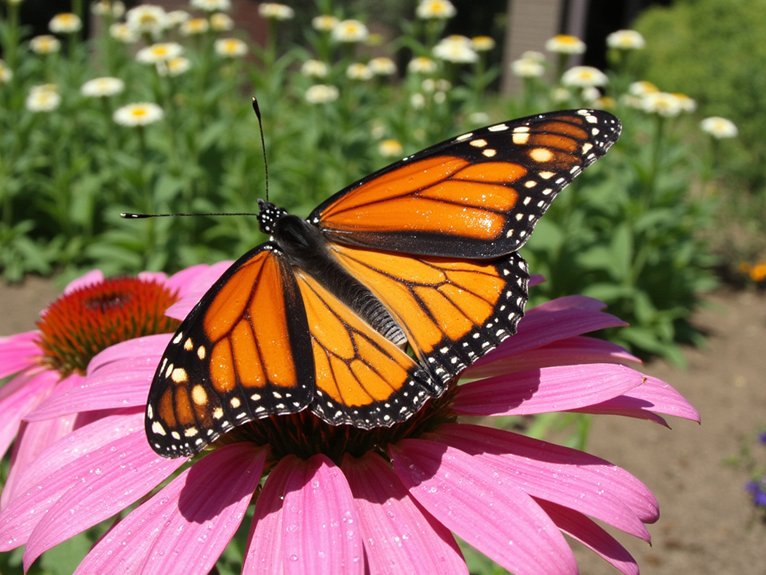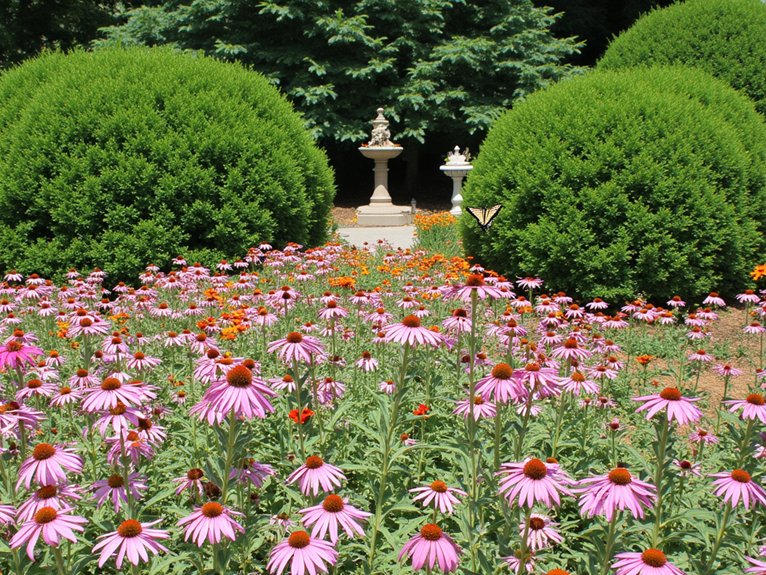Butterflies evoke mixed reactions among gardeners, from delight at their pollinating prowess to concern over potential crop damage. According to entomologist Dr. Sarah Chen, “These insects represent nature’s delicate balance between benefit and risk.” While some species support garden health through pollination and biodiversity, others can devastate vegetable patches in their larval stage. Understanding which butterflies help or harm a garden enables better management decisions and creates ideal conditions for both plants and beneficial species.
Contents
Understanding the Butterfly’s Role in Your Garden

While butterflies are often admired for their delicate beauty, these insects play an essential role in maintaining a healthy garden ecosystem. Their butterfly behavior includes visiting multiple flowers while collecting nectar, making them efficient pollinators that help plants reproduce and thrive.
These winged visitors actively seek out nectar sources throughout the growing season, transferring pollen between plants as they feed. Beyond pollination, butterflies serve as indicators of environmental health and contribute to local biodiversity by attracting birds and other beneficial wildlife to gardens. Understanding their vital role helps gardeners appreciate these insects beyond their aesthetic appeal.
The Butterfly Life Cycle: From Egg to Adult
Understanding the butterfly’s remarkable transformation begins with its four distinct life stages – egg, caterpillar, chrysalis, and adult butterfly. Each phase serves a significant role in development, starting with egg development on specific host plants.
The tiny eggs hatch into hungry caterpillars that immediately begin feeding on leaves. Caterpillar behavior focuses almost entirely on eating and growing, with some species increasing their body mass by 2,000 times. After several molts, the caterpillar forms a protective chrysalis where it undergoes metamorphosis. Within 10-14 days, an adult butterfly emerges, ready to continue the cycle.
Beneficial vs. Harmful Butterfly Species

Most butterfly species provide valuable benefits to gardens and ecosystems, though a select few can pose challenges for vegetable crops. Beneficial species like Monarchs and Swallowtails assist with pollination and enhance biodiversity, while harmful species such as the Cabbage White can damage brassicas.
The key is identification: beneficial species typically have bright, distinctive wing patterns and feed primarily on flower nectar. In contrast, harmful species like the Cabbage White display plain white wings with black spots. Their caterpillars, rather than the adults, cause crop damage by feeding on leaves and developing heads of cabbage family plants.
Protecting Your Plants From Problem Butterflies
Garden protection starts with several reliable methods to guard against problematic butterfly species. Effective monitoring techniques include daily plant inspections, particularly on leaf undersides where eggs are commonly laid. Installing row covers creates physical barriers while still allowing sunlight and water to reach plants.
For extensive pest management, gardeners should:
- Remove eggs and caterpillars by hand
- Apply organic deterrents like neem oil
- Plant sacrificial crops away from main gardens
- Encourage natural predators such as birds and wasps
- Use companion planting with strong-smelling herbs like thyme and sage
These preventive measures help maintain healthy crops without harming beneficial butterfly species.
Creating a Butterfly-Friendly Garden That Thrives

While planning a butterfly sanctuary requires thoughtful design, creating an inviting habitat brings lasting rewards for both pollinators and gardeners. A successful butterfly garden incorporates diverse nectar sources like zinnias, lantana, and butterfly bush, planted in sunny locations with wind protection.
Host plants are equally essential, providing food for caterpillars and encouraging butterfly reproduction. Include milkweed for monarchs, dill for swallowtails, and native species that support local populations. Arrange plants in clusters, offering landing zones and shelter.
Maintain chemical-free practices and provide shallow water sources. This balanced approach creates a sustainable ecosystem where butterflies thrive naturally.
